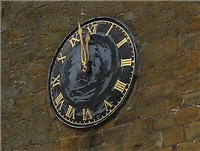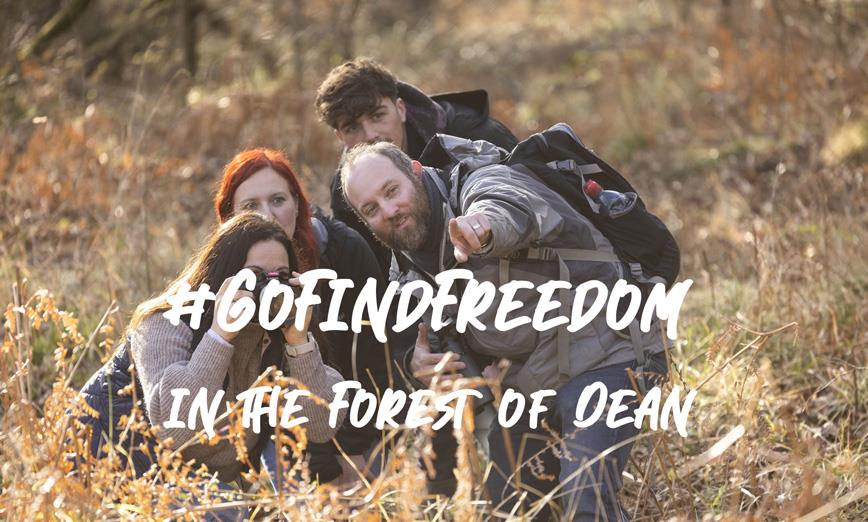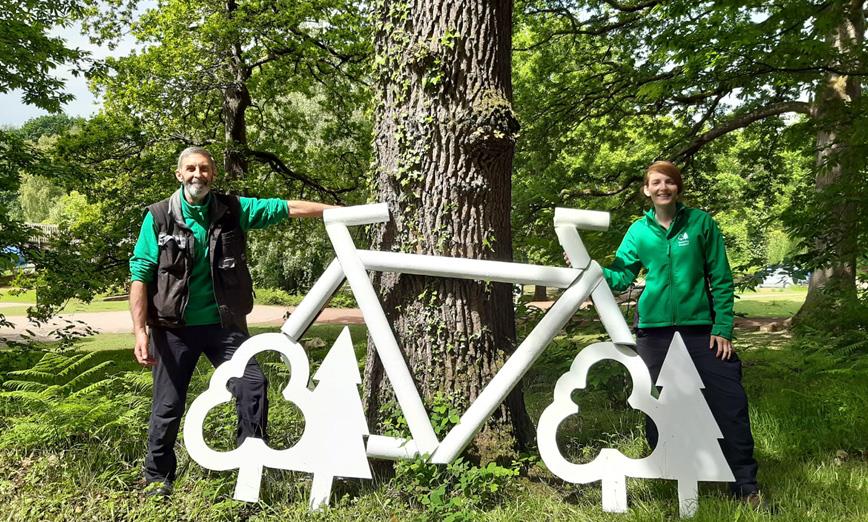- Stay
- What's On
- Things To Do
- Food & Drink
- Explore
- Inspiration
- Offers
- Weddings
- Blog
My Planner
- Stay
- What's On
- Things To Do
- Food & Drink
- Explore
- Inspiration
- Offers
- Weddings
- Blog
You are here: Explore > History & Heritage > The Fascinating Facts of the Dean Wye
Some of the fascinating facts, myths, legends and tales about the Forest of Dean and Wye Valley:
It's Never 11 o'clock in Littledean
The 12th century parish of Littledean is dedicated to St Ethelbert, the 8th century saxon king. It's worth looking up if you visit Littledean, at the tower on St Ethelbert's Church to the south of the village.  The obvious first thing you'll notice is that the spire is just a stump, having been destroyed in a gale in the 1894. But look carefully at the clock face... where there should be the roman numeral for eleven - XI - it has been wrongly painted as nine - IX! So it's never 11 o'clock in Littledean.
The obvious first thing you'll notice is that the spire is just a stump, having been destroyed in a gale in the 1894. But look carefully at the clock face... where there should be the roman numeral for eleven - XI - it has been wrongly painted as nine - IX! So it's never 11 o'clock in Littledean.
Tintern Abbey
The Cistercian abbey of Tintern is one of the greatest monastic ruins of Wales. It was the second Cistercian foundation in Britain, and the first in Wales, and was founded on 9 May 1131 by Walter de Clare, lord of Chepstow. It soon prospered, thanks to endowments of land in Gwent and Gloucestershire, and buildings were added and updated in every century until its dissolution in 1536. Since the early 20th century, every effort has been made to keep standing one of the finest and most complete abbey churches in Wales.
William Wordsworth visited Tintern in 1798, returning 5 years later, to write the poem "Lines composed a few miles above Tintern Abbey", saying that "no poem of mine was composed under circumstances more pleasant for me to remember than this".
Offa's Dyke
A 1,200 year old, linear earthwork roughly following the England/Wales border much of it still remains to be seen today. Possibly built due to a border dispute, its origins however, are shrouded in mystery and the experts really don't know why it was built. The dyke is attributed to Offa, King of Mercia from 757 to 796; Mercia was much of Southern England. The dyke ran from the estuary of the River Dee in the north to the River Wye in the south. The Offa's Dyke Path was opened in 1971 following a total of 177 miles of spectacular landscape. Find out more about the path here.
Early Man
On the Doward near Symonds Yat, there are signs of an early settlement in the Wye Valley, as evidenced by the remains of the iron age hillforts at Little Doward and Symonds Yat, and King Arthur's Cave on the slopes of the Wye.
The Longstone, Buckstone, Toad's Mouth and Broadstone near Staunton, Coleford are Standing Stones that date back to the Bronze and Iron Ages. When Lord Nelson and Lady Hamilton visited Monmouth in 1802 the Buckstone was painted white in their honour. The stone used to rock on its base until 1885 when a group of travelling actors and the landlord at the Agincourt Inn in Monmouth dislodged it and sent it crashing down the slope. It split into several pieces, but was hauled back up the hill, was cemented together in place and no longer rocks.
The Harold Stones in Trellech, Monmouthshire, are three large monoliths of conglomerate stone, commonly referred to as pudding stone. They date back to the Bronze Age and it is thought they were dragged to the site on logs and levered into position, probably either for seasonal information or for use at religious ceremonies. Some believe that they were aligned on the winter solstice with the Skirrid mountain, also known as the "Holy Mountain of Gwent".
Ships and the Navy
It may seem unlikely but the area has a long connection with the sea!
Lydney's harbour area was always strategically important, allowing the ships that opposed the Spanish Armada to be built here from the Forest's great oaks. This was actioned by Sir William Wintour, Admiral of the Fleet of Queen Elizabeth I in 1588, who was granted the manor of Lydney.
The Forest grows the country's largest area of mature oak - thanks to Nelson. The naval hero visited in 1802 looking for shipbuilding timber and was left concerned by how little was left. Thirty million acorns were planted, but by the time the trees had grown, ships were made of iron and steel. During that same visit Nelson visited the Kymin to see the Naval Temple built by the citizens of Monmouth to commemorate the naval triumphs of the napolonic wars. Today the museum in Monmouth has possibly the best collection of Nelson memorabillia in the country.
Myths and Legends
There are many historical legends, ancient myths and terrifying ghost stories that surround the Forest of Dean and Wye Valley. From the historic folk tale of the Ruardean Bear to the iconic legend of the Devil’s Pulpit, read about them all and explore our Myths & Legends Trail here.
Famous People
From modern day authors to the founder of Horlicks, read about some of the famous people who have come from and lived in the Forest of Dean and Wye Valley here.
Find Out More About the History of the Dean Wye:
Find Your Freedom
- We have a very rich heritage here in the Forest of Dean and Wye Valley of which we are rightly proud. A former royal hunting forest, the Dean has a long past as a source of timber for ships and building, coal, charcoal, iron ore, ochre and limestone.
- From the time of the Norman conquest in 1066 until 1971 the Dean was a Royal Forest. It was used by the Normans as their personal hunting ground and kept stocked with deer and wild boar. Its history is rich and fascinating.
- Explore the historical legends, ancient myths and terrifying ghost stories that surround the Forest of Dean and Wye Valley. From the historic folk tale of who killed the Ruardean Bear to the iconic legend of the Devil’s Pulpit overlooking Tintern Abbey, the bleeding stone at Staunton and the trial of the last person charged with witchcraft in Gloucestershire...
©Visit Dean Wye 2025. All Rights Reserved.
*Visit Dean Wye is the trading name of Forest of Dean & Wye Valley Tourism Limited.









